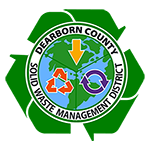Classroom Educational
Programs
Classroom Educational
Programs
Classroom Educational Programs
Programs are available for schools, youth, and other community organizations upon request. To ensure the best availability please reserve dates with advance notice. Programs can be adapted to fit in with current lessons. Standards information available by request. Programs are approximately 30-45 minutes.
Contact District Educator/Outreach Coordinator Stefanie Hoffmeier to schedule programs.educator@dearborncounty.in.gov or 812-926-9963 Click here for a printable program brochure Click here for additional educational resources
| Programs | Grade Levels |
|---|---|
| Compost Stew | K-1 |
| 3Rs | K-2 |
| Litter Bugs | K-2 |
| Freddy the Fish | 2-4 |
| Renewable Is Doable | 3-4 |
| What A Mess | 3-4 |
| How Do They Do That? | 3-5 |
| Edible Landfill Cookie | 4-6 |
| Landfill In A Bottle | 4-6 |
| Worm Composting | K-8 |
| Household Hazardous What? | 6-8 |
| Paper Recycling | K-12 |
| Enviro-Jeopardy! | 6-12 |
| E-Waste: When To Pull The Plug | 6-12 |
Compost Stew (K-2)
Using a rhyming story, students are introduced to the concept of waste reduction through composting. Students participate in a sorting activity and learn which items are compostable.
3Rs (K-2)
Students hear a story, participate in a sorting activity and come up with ideas about reducing, reusing, and recycling.
Litter Bugs (K-2)
This program combines a presentation of the storybook The Wartville Wizard (about a town of litter bugs who learn to stop littering) with a classroom clean-up activity.
Freddy the Fish (2-3)
Students travel with Freddy as he journeys downstream, encountering pollutants along the way. During the interactive story, students add “pollutants” to Freddy’s water so that they can see the impact on it.p>
Renewable is Doable (3-4)
This lesson teaches students about renewable and non-renewable natural resources, scarcity, alternative energy sources, and how recycling helps conservation efforts. Participants collect “natural resources” in a game to demonstrate consumption.
What a Mess! (3-4)
Students are introduced to the four categories of waste disposal: trash, recycling, compost, and Household Hazardous Waste. They play a game to sort items into these categories.
How Do They Do That? (3-5)
Students learn about the process of turning a tree into paper or bauxite into aluminum cans, then the class discovers how the process changes when people recycle. Participants learn about energy use, renewable and non-renewable resources.
Edible Landfill (4-6)
Using a variety of edibles, students learn how landfills are designed and managed. Emphasis is placed on how much waste they generate and the content of that waste. They will learn about the importance of recycling and composting in waste reduction. At the end, they get to eat the treat!
Landfill In A Bottle (4-6)
This lesson uses the same concepts and lesson as the Edible Landfill, except that students create a landfill in a bottle, rather than an edible treat.
Worm Composting (K-8)
Vermicomposting is fascinating forall ages. Students learn all about vermicomposting worms and their role as nature’s composting critters. Each student examines and touches a worm.
Household Hazardous What? (6-8)
Students identify and sort household products based on purpose and content. They learn about use and disposal methods to improve human and environmental safety. After discovering the hazards posed by some household products, students help think of safer alternatives.
Paper Recycling (K-12)
Students learn about how the paper they use every day is made, as well as the energy and resources that go into the production of paper and the details of its manufacturing. Students use paper from the recycling bin to make their own paper to take home. Seeds can be added to make a special paper gift.
EnviroJeopardy! (6-12)
Just like on the game show, students work on teams to buzz in and ask the right question for clues ranging in focus from plastic facts to composting and environmental disasters. Recycled content prizes awarded for winning and participation.
E-Waste: When To Pull The Plug (6-12)
Electronics have become one of the fastest-growing parts of the waste stream. In this lesson, students will learn about the harmful and beneficial components found in electronics, as well as the way electronics are recycled. Participants will be able to open upan electronic device to see and understand what recyclable materials are contained inside.
Need another program that isn’t listed?
We can also put together a fully customized program to fit your needs.
ADD ONS
Reuse (K-12)
A reuse project can be added to most programs to help reinforce the message. The reuse activity can be done immediately following the program or can be left for the class to do later.








